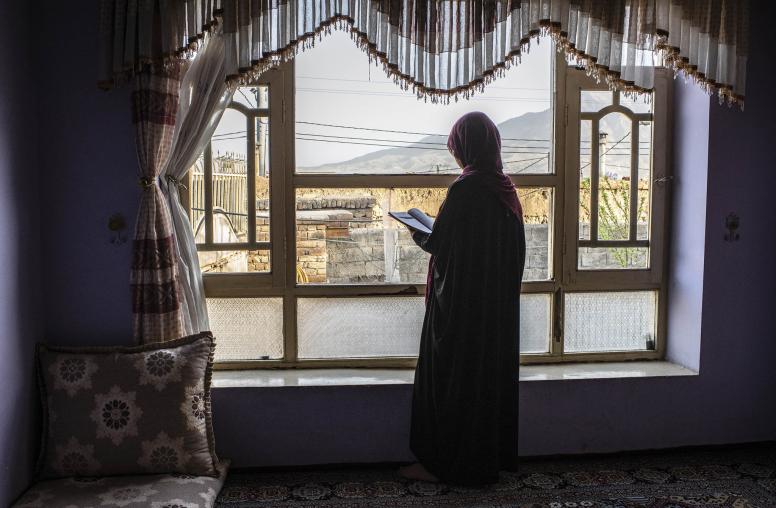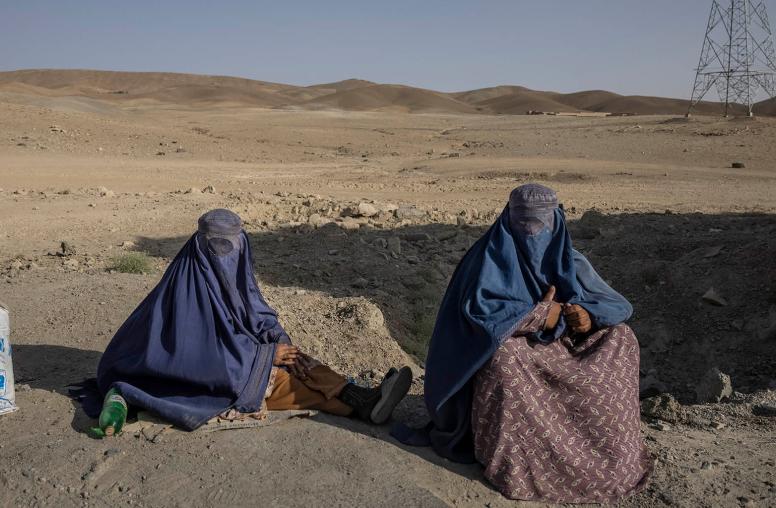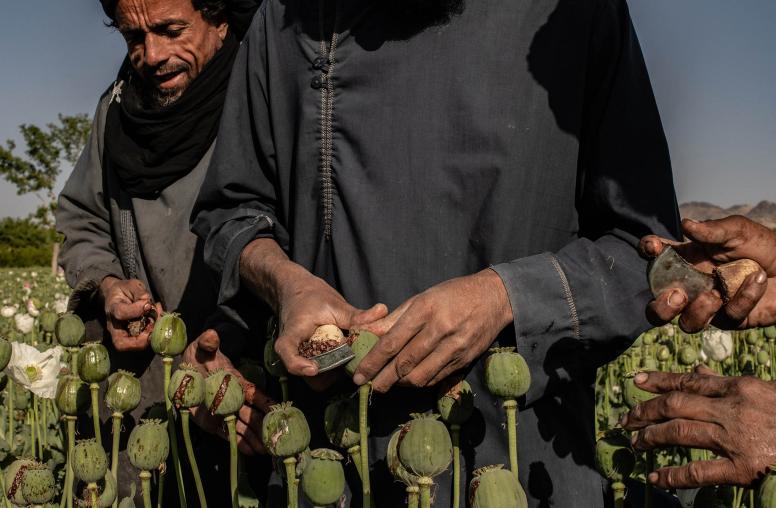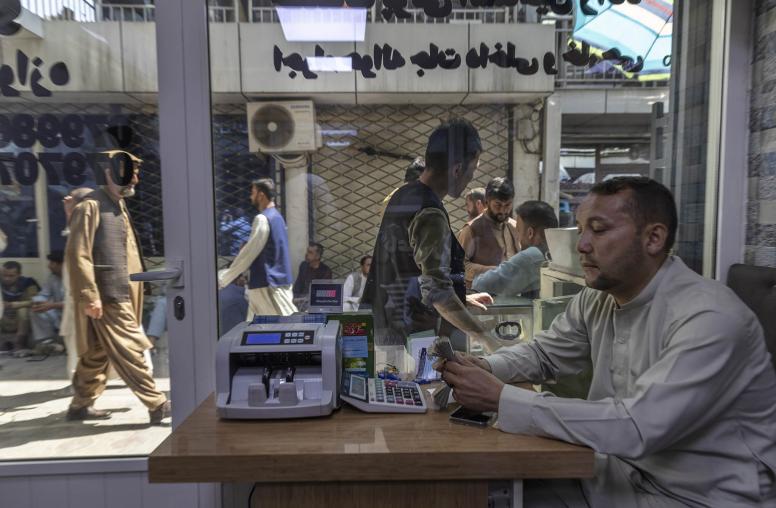Iran’s Protests ... and the Afghan Sisters Next Door
Afghan and Iranian women’s movements share a struggle, a language—and an opportunity.
Iran’s women are seizing worldwide admiration with 26 days of courageous defiance against their authoritarian government’s violent confinement of females as second-class citizens who may not freely work, marry, divorce, travel or even be seen with their heads uncovered. Less noted are this audacious movement’s existing, and potential, connections to the tenacious, 14-month campaign by Afghan women resisting the even tighter oppression of the Taliban. Street protest slogans, social media posts and other links illustrate a synergy between the movements that both should use in the difficult task of converting their inspiring courage into real change.

Iran’s Unprecedented Uprising
Iran’s widened protests this week, including workers’ strikes and Iran’s vital oil sector, underscore that its women are now leading the most potent challenge in years to the authoritarian rule by clerics and their allied security forces. The uprising began as a protest against the death of a young woman, Mahsa Amini, in the hands of Iran’s morality police, who arrested her on a Tehran street for allowing some of her hair to stray from beneath the head scarf that her government requires all women to wear in public.
“Protest chants about her death quickly evolved into calls to oust the regime,” USIP fellow and Iran specialist Robin Wright wrote this week. They began chanting “‘Death to the Dictator,’ and ‘Our disgrace is our incompetent leader,’ and ‘We don’t want the Islamic Republic.’” In a default response, Iran’s security forces, such as the Basij militia, have attacked protesters, multiplying popular anger. As of Tuesday, those attacks have killed 185 protesters, including 19 children, reports the monitoring group Iran Human Rights.
Iranian women have protested Iran’s narrow, discriminatory theocracy since the 1979 revolution that erected it in place of the ruling monarchy. Indeed, Wright notes, “The first protest after the ouster of the shah was a women’s rally demonstrating against the imposition of conservative Islamic dress. … Women led much of the 2009 Green Movement protests against an allegedly fraudulent presidential election, chanting ‘Where’s my vote?’ and ‘Death to the Dictator!’”
Iranians’ demands for reform have grown stronger in recent years and news accounts, tracked by USIP’s Iran Primer, reflect how the current uprising has won unprecedented support from a broad swath of Iranian society.
Afghanistan, Iran: Sisters’ Synergy
Like other nonviolent protest movements of the past decade, in Sudan, Tunisia, Libya, Myanmar and elsewhere, the Afghan and Iranian women’s campaigns are using social media as vital amplifiers. Despite their governments’ obstructions of the internet, the two movements can share ideas more quickly because both can discuss them in the Persian language. Women demonstrators in both countries have been using the same Persian-language slogan — “Zan, Zindagi, Azadi” (“Women, Life, Liberty!”) — against their governments’ efforts to control their bodies and choices.
An Iranian protest group called Khiaban Tribune, which is painting street graffiti as part of the protests, last week posted its support for Afghan women, who have defied arrests, beatings and other violence by the restored Taliban regime. The Iranian group declared, “we are both fighting … against a Taliban.” Activist writer Masih Alinejad and other Iranian women campaigners have echoed the comparison between the two countries’ regimes and women’s responses.
Over the 20 years in which a U.S.-led international intervention held Afghanistan’s Taliban out of power, millions of Afghan women won greater freedoms to study, pursue careers and hold public roles in society. Women served as judges and provincial or district governors, headed four national government ministries, held between 20 and 30 percent of parliament seats (compared to about 6 percent in Iran), and ran for president and vice president. A generation of Afghan women built a foundation of experience and skills that they are now using to resist the re-imposition of misogynist oppression by the new Taliban regime, winning local-level concessions from officials in various provinces who are relaxing enforcement against women’s activities to avoid drawing public protest.
A throng of countries offered years of support for Afghan women’s struggles via government aid programs, civil society campaigns, TV talk shows, parliament sessions and national and international conferences. Many Iranian women’s rights activists lament that their own movement has had vastly less international support. But with the Taliban’s return and Iran’s crisis, the two women’s movements are sharing — and can increase — much-needed support for each other.
Afghans’ Continued Resistance
Retaking power in August 2021, the Taliban quickly replaced Afghanistan’s women’s affairs ministry with a “Ministry of the Propagation of Virtue and Prevention of Vice,” an organ that was highly oppressive during the Taliban’s 1990s rule. Taliban spokesmen protest to the international community that their regime intends to moderate past oppressions and respect women’s basic rights, but Taliban actions have steadily tightened restrictions. In the past six months, the regime has:
- Dissolved the Afghan Independent Human Rights Commission, for years the nation’s most prominent human rights authority and long directed by women.
- Ordered women to cover their faces in public.
- Halted the issuance of driving licenses to women and banned women from using public transportation unless accompanied by a close male relative, called a mahram. The Taliban’s restored Ministry of Vice and Virtue ordered bus drivers to install curtains to close off the designated seats for women in buses.
- Ordered schoolgirls in the fourth to sixth grades in Ghazni province to cover their faces while walking to or from school, or to face expulsion.
- Banned women from going to public parks where authorities cannot ensure segregation between men and women.
- Instructed women employees of the Finance Ministry, in phone calls to each one personally, to send male relatives to their offices to replace them.
Afghan women began a wave of protests in the days after the Taliban seizure of power, rallying in the capital, Kabul, and in towns across many provinces, including Balkh, Herat, Kunduz, Baghlan, Takhar, Kapisa, Panjshir and Bamyan. Taliban enforcers beat protesters with batons and arrested them, both women and men. They also arrested protesters’ family members. Under this assault, women this year began holding smaller protests. Fourteen months on, women are gathering in offices or homes to produce photos and videos in which, masked for security, they present speeches and signs with their demands for justice and then share them via text messages, WhatsApp, Twitter or Facebook.
Still, Afghan women also continue to defy the Taliban with periodic public rallies, including street protests this month against an increase under Taliban rule of attacks and hate speech against Afghanistan’s ethnic Hazara minority, who are adherents of Islam’s Shia sect, which also is a minority in a country dominated by Sunni Islam. These latest rallies condemned a horrific September 30 bombing in Kabul that killed more than 35 ethnic Hazara girls and women at a school. The women activists in Iran, a Shia-majority country, have joined Afghan women in specifically condemning the attacks on the Hazaras. As both the Iranian and Afghan authoritarian regimes suppress ethnic and religious minorities as well as women, the two women’s movements should strengthen efforts at building coalitions with other marginalized communities to more powerfully press for real democratic change.
In both countries, some religious clerics have supported the demands of women that authorities stop using force to require women to adhere to government requirements that they cover their hair or faces. In Iran, these include former president Mohammad Khatami. In Afghanistan a group of 15 religious scholars published a statement via social media that called such coverings a moral choice rather than a subject of criminal law.
In the past month, Afghan women have drawn their own inspiration from Iranians’ protests. On September 29, about 25 Afghan women activists protested outside Iran’s embassy in Kabul, waving signs declaring, "Iran has risen, now it's our turn!" and "From Kabul to Iran, say no to dictatorship!" the AFP news agency reported. Taliban gunmen soon arrived and unleashed volleys of automatic rifle fire to disperse the group.
Building a Sisterhood
One lesson that Afghan women may be drawing from Iran’s protest movement is the need to bolster the support they receive from men in their communities. Afghan men — district-level officials and elders in Kandahar, Paktia, Parwan and Baghlan provinces, for example — have joined women in pushing for the resumption of girls’ schooling that has been halted by the Taliban. But Afghan women have noted the much greater prominence of men publicly with women in Iran’s protests and have said the same is needed in Afghanistan.
Alongside mutual encouragement, the Afghan and Iranian women’s rights campaigns can offer each other complementary elements of support. Afghans provide an example and experience of managing a longer, lower-profile resistance movement under the extremely harsh repression of the Taliban. And with the reduced global attention to Afghanistan following last year’s withdrawal of international troops and most government and non-government assistance programs, it is the Iranians who are galvanizing world attention right now for the goals that the two movements share.
It is only natural that two communities tied by language, culture and their oppression by authoritarianism masquerading as religious faith, are finding synergies. With women in both Iran and Afghanistan facing crisis and opportunity, it is time to strengthen their connections. Whether in person, or on the cellphone screens that feed millions of women and girls in these neighboring countries with emotional support, organizational ideas and clearer visions for their future, Afghan and Iranian women must now all the more strengthen each other as sisters.



